| Please note that these pages are from our old (pre-2010) website; the presentation of these pages may now appear outdated and may not always comply with current accessibility guidelines. |
| Please note that these pages are from our old (pre-2010) website; the presentation of these pages may now appear outdated and may not always comply with current accessibility guidelines. |
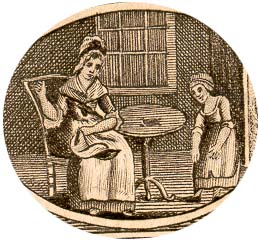
| This month's book choice features a set of ten children's chapbooks. These illustrate the type of children's literature that was available to the mass population in the early 19th century. |
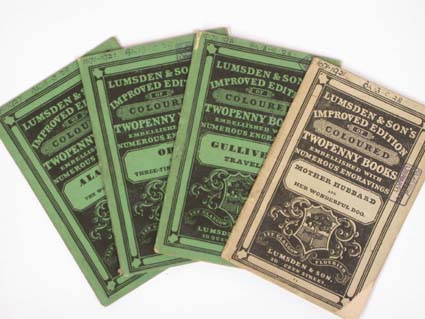 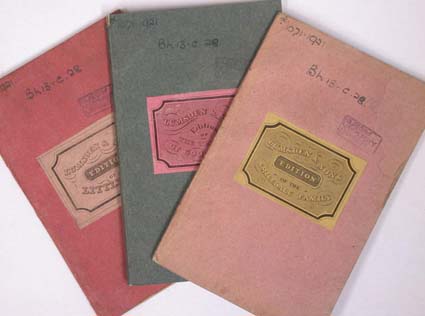 Some of the items that make up the set |
| Chapbooks were so-called after the pedlars or hawkers known as 'chapmen' who travelled from place to place and sold the booklets along with other small household items such as ribbons, threads and needles; in towns, chapbooks would be sold on the streets or at gatherings such as fairs. These small books had a varied subject matter including popular tales, accounts of marvels, fairy tales, religion, executions and fortune telling. While originally chapbooks had been printed for an adult readership, increasingly they were printed for the juvenile market. |
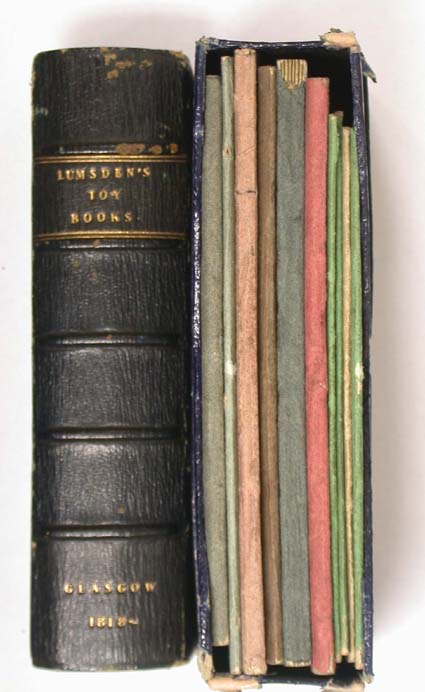 The boxed set |
The items are held in a box which is stamped on the
"spine" Lumsden's Toy Books with the imprint information "Glasgow
1818-". Some books were sold as boxed sets in the 19th century. However, it is not known at what stage these books were boxed in
this way, or by whom.
According to The Oxford Encyclopaedia of Children's Literature, the term toy book broadly describes books that were intended for fun and play rather than instruction, although it usually more specifically meant books that were designed to be played with, such as shape books. In common with many children's stories of the time, most of these items have a didactic tone and incorporate a moral to be learned. Children's literature was heavily influenced by the philosophical ideas of John Locke and Rousseau, who saw children's minds as a tabula rasa or clean slate, ready to be moulded. Contained in the box are:
|
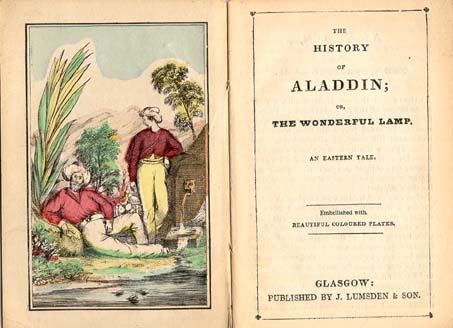 The History of Aladdin; or The Wonderful Lamp. |
Stories in chapbooks were often unauthorised abridgements of popular
works. For example, The Adventures of Captain Gulliver, in a voyage to Lilliput is an abridgement of the famous story by Jonathan Swift. To chapbook publishers, the Lilliput and Brobdignag voyages seem to have been the most popular of Gulliver's adventures, while the other voyages from the original novel do not seem to have been used. Another famous tale, Beauty and the Beast, was a chapbook favourite. Originating in France, the first published version of the story by Madame de Villeneuve in 1740 was superseded by the more popular abridged version by Madame de Beaumont. This chapbook version has a moralising tone, common in children's books of the period. The History of Aladdin; or The Wonderful Lamp, has been based on one of the most popular of the tales from 1001 Arabian Nights; it is frequently featured in chapbooks. |
| Not all the stories have remained as children's favourites. The
history and adventures of Obi; or three-fingered Jack recounts the
story of a man who is considered invincible until his Obi or evil
talisman is destroyed. Other versions of this story, including a
pantomime, maintain that it is based in part on a true story
from Jamaica in 1780. While its themes of murder, mysticism, slavery and beheading would be considered unsuitable for modern children, its combination of adventure and magic realism made it ideal chapbook material. |
|
|
|
A feature of chapbooks is the frequent lack of reference to an author. This could
be attributed to the desire to give the perception that the chapbook was an
extension of the oral tradition of stories told from time immemorial. |
| A highly popular tale, Goody Two Shoes, was printed by several
chapbook publishers and remained a popular didactic tale into the 19th century.
The copy here has a pencilled note from an unknown reader on the
inside front cover, attributing the story to Goldsmith. This alludes to the popular notion that the story was the work of Oliver Goldsmith, author of several works including She Stoops to Conquer. However, other sources have attributed the tale to chapbook publisher John Newbery or Giles Jones. This copy also has an additional tale, The adventures of her brother Tommy, which tells of his adventures after the tearful farewell of the siblings in the main story. |
|
|
|
Not all the chapbooks in this set focus on improving young minds.
Vicissitude is described as an original comic song for the
entertainment of all good boys and girls in the British Empire. It
recounts the ups and downs of the life of Ned Frolic.
|
|
Nursery rhymes also feature. Old Mother Hubbard and her wonderful dog is an age-old tale, brought to life here with coloured plates. The tale of the old woman and her entertaining dog was first published in 1805, although the character is credited as being the oldest dame in nursery literature, with roots going back as far as 1591. The book also includes The First Blossoms of Learning or a new alphabet for children. This is the only example in the set where the illustrations do not completely match up with the text. There are pictures throughout the item, but they only relate to the nursery rhyme, not the alphabet.
|
|
|
|
The books in this set are not of a uniform appearance and feature a
range of slightly differing sizes and different kinds of paper. There
are four two-penny books that have blockprint covers, giving the
title of the book on front and back. Advertising for prints and maps
are also included on the back of each item.
|
|
|
Coloured illustrations feature in five of the items. They are crudely hand-coloured, but they do seem mostly to correspond to the accompanying content - which is not always the case in chapbooks. It has been reported that children were often employed by chapbook publishers to colour their engravings, although it is not known if that was the case here. The other items are embellished with what are described on the title-pages as "elegant" cuts or engravings. Both woodcuts and engravings were used in chapbooks. |
|
|
|
The majority of the items in this set are undated, as is common with
chapbooks. They were published and sold by James Lumsden and Son, a highly regarded stationery company.
Besides chapbooks, Lumsdens printed a lot of ephemeral items such as minutes, bills and adverts.
According to Neuberg, they printed chapbooks between 1814-1826.
Based in Glasgow, the company's high standing is reflected in the
fact that it gave the city two Lord Provosts.
This set of children's books is from the Wylie collection. Amassed by Robert Wylie, chairman of the Glasgow firm of furnishers, Wylie & Lochhead, and a founder member of the Glasgow Bibliographical Society, the collection consists of almost 1,000 volumes relating to the history and topography of Glasgow and its environs from the 18th century to the early 1900s. Included is a substantial amount of ephemeral material, including chapbooks, broadsides, playbills, and advertisements. In addition to the chapbooks in the Wylie collection, there are a wide range of chapbooks across the collections. Our chapbooks catalogue lists those held in Special Collections, as well as holdings for Edinburgh Central Library, Stirling University Library and the National Library of Scotland. It is a very useful resource for those wishing to explore the fascinating world of chapbooks further. |
Other items of interestOther examples of nineteenth century children's chapbooks
published by James Lumsden and Son held in Special Collections: More generally, there is an extensive collection of ephemera in Special Collections: see, for example, the descriptions for broadsides and chapbooks, and also digitised examples of broadside ballads, and hanging ballads. The following works have proved to be useful in writing
this article: |
|
Return to main Special Collections Exhibition Page Sharon Lawler May 2008
|